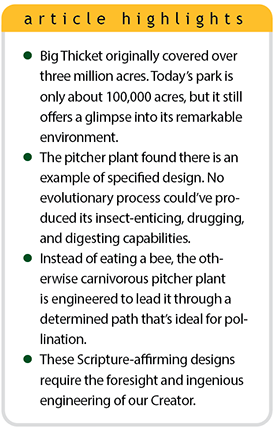 In the early 1800s, pioneers of Southeast Texas initially avoided Big Thicket. Its more than three million acres embraced dense forests, swamps, and few people. Subsistence farmers soon penetrated the thicket in search of solitude. They traded with Coushatta and Alabama Native Americans who had hunted bear and deer there for over a century. Those who kept cattle contended with Karankawas and Comanches. Outlaws and Civil War draft dodgers hid from authorities within its vast foliated lowlands.
In the early 1800s, pioneers of Southeast Texas initially avoided Big Thicket. Its more than three million acres embraced dense forests, swamps, and few people. Subsistence farmers soon penetrated the thicket in search of solitude. They traded with Coushatta and Alabama Native Americans who had hunted bear and deer there for over a century. Those who kept cattle contended with Karankawas and Comanches. Outlaws and Civil War draft dodgers hid from authorities within its vast foliated lowlands.
Tar and oil oozed to the surface in some spots. The early 20th-century oil boom brought overnight prosperity to those who harvested the crude. Texaco, Inc. was born in Big Thicket. Entrepreneurs depleted those deposits, but the people who had pursued oil or timber thinned out the Big Thicket.
By 1974, after long negotiations between government, landowners, and businesses, Big Thicket National Preserve was established. Today, it includes a patchwork of almost 100,000 acres.1 A hike through its biodiverse pine forests evokes appreciation for the providence of God, who lets us enjoy these fruits of pioneer and preservationist labors. One creation wonder found here is the pale pitcher plant (Sarracenia alata).
A Day in the Life of a Pitcher Plant
Pitcher plants grow from swamp-submerged roots every spring. Small leaves appear first, then flowers. Pitcher-shaped leaves grow after the flowers fade. Each pitcher looks like a vase made out of one leaf with a hood (operculum) like a tiny tarp draped over the opening. These pitchers use a suite of features to catch creepers like insects or slugs. The plant absorbs nutrients such as nitrogen from its captives. This comes in handy in areas where sandy soils have few nutrients.
Three facets of each pitcher point to divine design. First, the specificity of its shapes declares design. Each pitcher’s hood exposes enough of the pitcher’s mouth to receive rainwater. This mixes with trapped insects and plant-produced enzymes to make a nutritious soup. The hood’s underside and the pitcher’s lip manufacture nectar laced with a narcotic.2 When insects from the wet forest floor partake of the nectar, the drug makes them sluggish. Fine inward-and downward-pointing hairs positioned on the hood’s underside and on the pitcher’s lip nudge prey toward the plant’s tube. Once inside, a waxy inner lining proves too smooth for even insect feet to cling to. The pitcher itself is too narrow for a takeoff, preventing flying insects from escaping.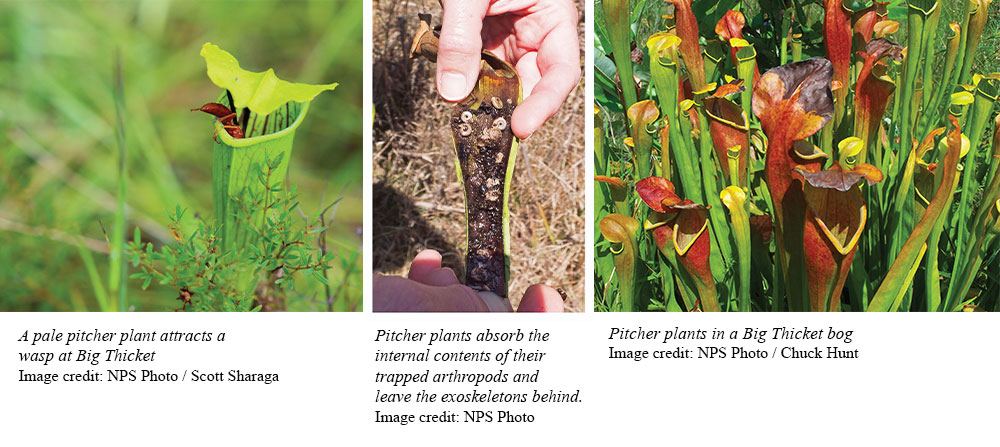 A second facet comes from coordinated features, which always arise from engineering. The insect drug alone, which would require lab experiments to replicate, offers enough evidence to convince us it was created. But someone integrated the plant’s chemistry set with fine-tuned shapes, textures, and colors that together confirm creation.
A second facet comes from coordinated features, which always arise from engineering. The insect drug alone, which would require lab experiments to replicate, offers enough evidence to convince us it was created. But someone integrated the plant’s chemistry set with fine-tuned shapes, textures, and colors that together confirm creation.
And there’s more. The plant places its laced nectar with enticing scents and sights at the top of the pitcher to attract lunch. It also secretes enzymes into the bottom of the pitcher, where it can digest that lunch. Shapes and textures combine with biochemistry and colors to coordinate a complete package.
Hard to “Bee”lieve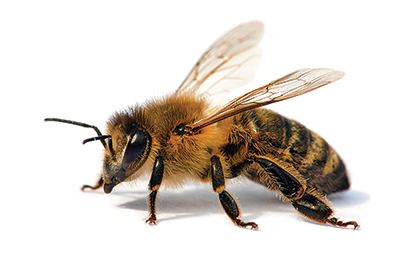
Only after its flowers fade do pitcher plants grow pitchers. Unlike the pitchers’ drugging nectar, these plants’ harmless flower nectar attracts and feeds honeybees. This way, their pitchers do not trap the honeybees they need to transfer pollen to the flowers of other plants. This process, called outcrossing, maintains hybrid vigor and thus the plants’ long-term genetic health. Without it, the flower would self-pollinate, which would result in inbreeding depression.
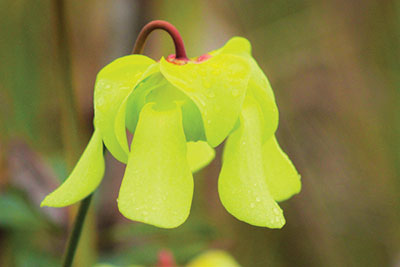
How does it ensure this outcrossing? It uses an elaborate setup. The arrangement of its flower’s parts anticipates honeybee bodies and behaviors. The flower’s petal and sepal arrangement permits bees only one entrance. On its way in, pollen from another flower brushes off the bee and onto the perfectly positioned part of the pistil that receives pollen, the stigma.
One flower petal hangs from the stalk like an upside-down umbrella. It gives the bee a platform from which to collect pollen placed just overhead. Then, in an expert arrangement, the honeybee cannot exit via the same path it entered. If it did, then it would pollinate the same flower. This presents no problem for our great Creator, the Lord Jesus. He designed Sarracenia flower petals as one-way-exit flap doors. He thought ahead when He put all this together. Thus, purposeful or goal-oriented construction is our third creation facet. It requires intelligence to anticipate needs.
Beware Nature-First Words
People often refer to pitcher plant design features with phrases like “highly evolved” or “highly modified.” Hogwash. Where can we see evidence that any natural process either could or did craft coordinated specifications for targeted purposes like nutrient capture or outcross pollination? Surely the plant itself has no knowledge of its need to preserve genetic fidelity. Someone outside the plant thought of that.
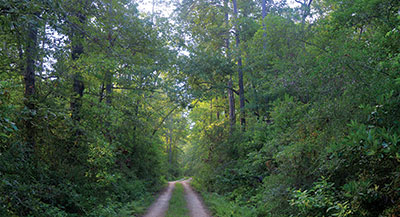
Romans 1:25 warns about those who would use nature-first phrases to deny the agency and preeminence of their Creator. They have “exchanged the truth of God for the lie, and worshiped and served the creature rather than the Creator, who is blessed forever. Amen.” Shame on anyone for crediting (worshiping) nature and time as though they were capable of the kind of craftsmanship that only our Creator could accomplish.
By including a Creator in our thinking, we obtain a real Engineer who ordered up the suite of specifications that demonstrate His handiwork in pitcher plants. Instead of “highly modified” (from what, nobody knows), we can say “highly specified.” We can then rightly praise the Lord Jesus, “through whom also He made the worlds” (Hebrews 1:2)—including the specific shapes, coordinated components, and purposeful parts in His pitcher plants.
Stage image: Iconic bald cypress trees in Big Thicket National Preserve in Southeast Texas
Stage image credit: USDA photo by Larry Rana, CC BY 2.0
References
- Callicott, J. B. et al. 2006. Biocomplexity in the Big Thicket. Ethics, Place and Environment. 9 (1): 21-45.
- Perhaps only some of the eight to 10 Sarracenia species produce the drug. Patel, N. R. and R. Krishnamurthy. 2014. Carnivory in pitcher plants: An enigmatic meat-eating plant. Research and Reviews in Biosciences. 8 (3): 94-106.
* Dr. Thomas is Research Scientist at the Institute for Creation Research and earned his Ph.D. in paleobiochemistry from the University of Liverpool.



















